How to kill anisakis (fish parasite) by rapid or flash freezing and prevent food poisoning
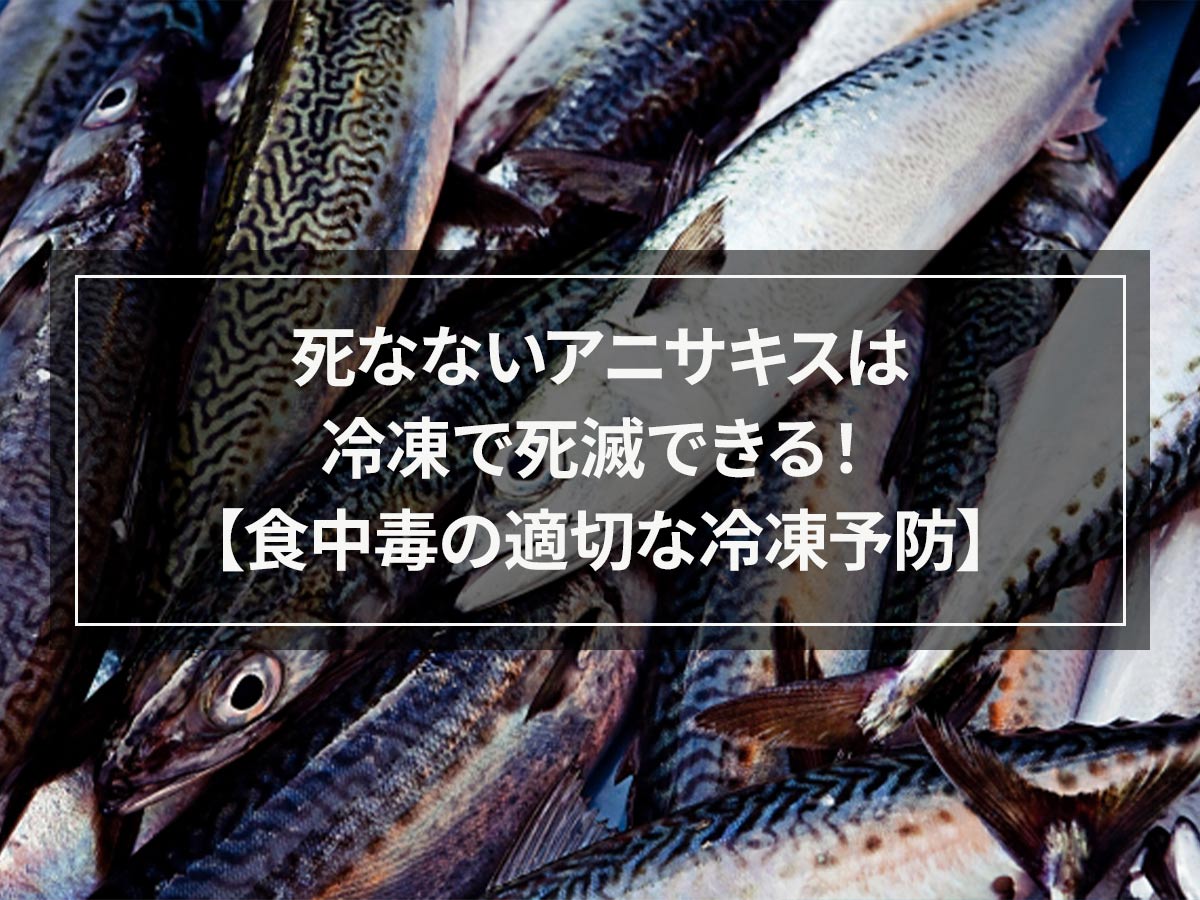
Anisakis is a parasite that lives in fish and can cause food poisoning if eaten. Food poisoning caused by Anisakis has increased 34 times over the past 10 years due to the increased consumption of raw fish. Many restaurants have been forced to suspend operations or close their doors.
Whether you want to eat sushi, sashimi, and other raw seafood without worrying about it, we will explain to you the effective ways of getting of this parasite.
Anisakis can be killed by heating and freezing. Freezing is an effective way to kill Anisakis, especially when serving raw food such as sushi or sashimi, but many people worry that freezing will reduce the quality of their product or food.
Therefore, our company, which has conducted freezing tests on more than 250 types of food, has looked into the symptoms of food poisoning caused by Anisakis and the freezing method that kills Anisakis while preserving the taste.
We also conducted a comparative experiment between slow freezing, rapid and flash freezing, and found that depending on the temperature setting, anisakis didn't completely die. We will also explain the differences between rapid/flash freezing and slow freezing when it comes to freezing Anisakis, and the benefits of rapid freezing based on our test results.
Please read until the end so that you can serve sashimi and sushi with peace of mind.
目次
- 1 What is Anisakis? What are the symptoms and treatment?
- 2 Which fish are most likely to be infected?
- 3 How to prevent food poisoning caused by Anisakis?
- 4Freezing method precautions
- 5 Demonstrating how to Anisakis by rapid and flash freezing
- 6 Observing temperature changes in commercial freezers and their limitations
- 7 How to prevent food poisoning while maintaining the quality with rapid and flash freezers
- 8 Examples of measures against Anisakis using rapid and flash freezing
- 9 What are the risks at home?
- 10Conclusion
What is Anisakis? What are the symptoms and treatment?

Anisakis is a type of parasite that is translucent, white, 2 to 3 cm in size, and shaped like a string.
Anisakis parasitizes fish that eat krill, a type of plankton, and grows in their internal organs. Anisakis larvae migrate from the internal organs to the muscles after the infested fish dies.
If you eat raw fish infested with Anisakis, the Anisakis will try to eat through your stomach and intestines, causing severe abdominal pain and nausea, which is called anisakiasis disease.
The symptoms of anisakiasis can be broadly divided into two: acute gastric anisakiasis and acute intestinal anisakiasis. In addition, you can also develop an anisakis allergy.
Acute gastric anisakiasis
Most food poisoning caused by Anisakis is acute gastric anisakiasis, which occurs when Anisakis enters the body and bites the stomach wall. Approximately few to several dozen hours after ingesting it, symptoms such as severe pain in the solar plexus and vomiting will start.
Acute intestinal anisakiasis
Acute intestinal anisakiasis occurs when anisakiasis enters the body and bites the intestinal wall, causing severe pain in the lower abdomen and symptoms of peritonitis several tens of hours to several days after eating. Symptoms appear later than in gastric anisakiasis, and in rare cases, intestinal obstruction or perforation may occur.
Anisakis allergy
In addition to gastric anisakiasis and intestinal anisakiasis, allergic reactions to anisakiasis may also include allergic symptoms such as hives, decreased blood pressure, and respiratory failure.
Gastrointestinal Anisakiasis disease will not develop if the Anisakis dies, but if you are allergic to Anisakis, symptoms may appear even if you eat the carcass of Anisakis.
There are many cases where people thought they had a "blue fish allergy" but actually found out they had an "Anisakis allergy." People who suspect they have an Anisakis allergy should be careful when eating fish in general.
Since Anisakis cannot live in the human body, it is said that if you wait for it to die, it will heal within a few days. However, it is accompanied by severe pain and there is a risk of serious illness and complications, so if you have any doubts, seek medical attention immediately.
No therapeutic drug has been developed for anisakiasis, and in cases of acute gastric anisakiasis, endoscopy is performed and the anisakiasis is removed with forceps. Acute intestinal anisakiasis can be treated symptomatically with oral medications, and in severe cases, surgical treatment may be required.
Seirogan, a Japanese gastrointestinal drug, was reported to be effective in preventing and relieving symptoms of anisakiasis, and it became a hot topic of conversation. However, according to the Pharmaceutical and Medical Devices Act in Japan, Seirogan is not recognized as having any effect on anisakiasis, and it has been shown to suppress gastrointestinal movements. It is said that this may be a temporary effect of adjusting the condition or reducing the movement of Anisakis.
Even if your symptoms are alleviated by taking Seirogan, we recommend that you visit a hospital if you suspect that you have Anisakiasis.
Which fish are most likely to be infected?
Anisakis may be parasitic on all kinds of seafood, but especially blue fish such as mackerel, horse mackerel, saury, and sardines, as well as squid, bonito, cod, and salmon. These are the fish where Anisakis are most likely to be found.
Mackerel
Mackerel has a high rate of Anisakis parasitism due to its habitat, and because it spoils quickly, Anisakis easily migrates from the internal organs to the muscles, and there is a high risk of Anisakiasis disease when consuming it.
Also, some people say that cured mackerel is fine, but Anisakis won't die even if you boil it with vinegar. Cured mackerel also carries risks, just like eating sashimi.
Sanma (saury)
Up until now, it was a rare fish to be eaten as sashimi, but with the development of transportation technology, opportunities to eat it raw have increased, and the number of cases of anisakiasis has increased. Like mackerel, it is important to be careful when eating this fish.
squid
Squid, like mackerel and blue-green fish such as saury, is also a seafood with a high risk of anisakiasis. Squid is often eaten as sashimi, so be careful when eating it raw.
Also, like vinegar, salt does not kill Anisakis, so you should not be careless with salted squid.
Bonito
Anisakis is generally common in bluefish and squid, but in 2018, the number of cases caused by Bonito increased 10 times compared to the previous year. It is thought that due to changes in seawater temperature, there may have been more prey for Anisakis in the areas where skipjack was caught.
Additionally, the number of cases of food poisoning caused by Anisakis is increasing year by year, and according to data from the Japanese Ministry of Health, Labor and Welfare, the number has quadrupled in two years, and has skyrocketed 34 times in 10 years.
The development of low-temperature distribution systems for fresh foods has made it possible to eat fresh seafood raw all year round, and changes in seawater temperature, such as the rapid increase of the parasite in Bonito, are thought to have had an impact.
So how can we prevent food poisoning caused by Anisakis?
How to prevent food poisoning caused by Anisakis?

The vinegar, salt, soy sauce, and wasabi commonly used in cooking in Japan do not work on Anisakis, and special method is required to kill Anisakis.
There are four preventive measures for food poisoning caused by Anisakis according to the Japanese Ministry of Health, Labor and Welfare.
https://www.mhlw.go.jp/stf/seisakunitsuite/bunya/0000042953.html
Remove internal organs while the fish is still fresh
Anisakis larvae migrate from the internal organs to the muscles when the fish dies.
The risk of Anisakis invading the edible parts increases as time passes after death, so if you remove the internal organs while they are fresh, you can remove Anisakis along with them.
However, there are no time guidelines and fish sold at supermarkets and fish stores are no longer fresh, so this method is not practical.
When purchasing fish, remove anisakiasis by taking the following measures that combine visual inspection, heating, and freezing.
Visually
Anisakis are visible in size, so if you closely inspect the surface or cross section of the food, you may be able to spot it.
However, even after double visual inspection and removal of Anisakis, there have been cases where food poisoning incidents occurred because not all the parasites were removed.
Visual inspection is important, but this alone is insufficient. Combining visual inspection with heating or freezing is a more effective method.
Cooking
Anisakis is sensitive to heat and can be killed this way. Cooking time and temperature are : cooking at 70℃ or higher, or heating for 1 minute or more at 60℃.
This will kill Anisakis and prevent food poisoning. This method is effective for foods that are cooked, but not for foods that are eaten raw, such as sushi and sashimi.
Freezing
Anisakis can also be killed by freezing. Freezing temperature and time: Freeze to the core for at least 24 hours at -20℃ . Home freezers are often -18℃, so freeze for at least 48 hours.
Anisakiasis that has been killed by heating or freezing will not come back to life, and even if you eat the carcass, you will not develop Anisakiasis disease.
(*In the case of Anisakis allergy, it does not necessarily mean that you will not experience symptoms if the Anisakis is dead.)
Freezing, in particular, kills Anisakis and is a preventive measure that is suitable for enjoying raw fish such as sashimi and sushi.
However, there is a pitfall in the freezing process for Anisakis.In fact, it is extremely difficult to maintain a temperature of -20℃ in a regular commercial freezer, and the temperature inside the refrigerator will rise without you even realizing it. There are cases where Anisakis does not die even after freezing.
Next, we will explain the precautions for killing Anisakis by freezing.
Freezing method precautions
The Japanese Ministry of Health, Labor and Welfare stipulates that "freezing food to the core at -20℃ for 24 hours or more" means keeping the temperature below -20℃ for 24 hours or more in a frozen state.
In normal home and commercial freezers, it takes about half a day for food to freeze, so it takes half a day to reach the starting point of 24 hours (48 hours for home use). In other words, judging from the time it takes to put it in the freezer, this is not effective in killing anisakis.
Furthermore, the freezer has a "defrost" function that removes frost from the fan that supplies cold air, and this function is used approximately four times a day. The temperature inside the freezer increases by approximately 5 to 10 degrees Celsius each time, and the temperature inside the freezer also increases when the door is opened and closed.
For this reason, commercial freezers are generally set at -20°C, which is lower than for home use, but it is extremely difficult to maintain the temperature inside the freezer at the set temperature (-20°C). Even if you put raw seafood in the freezer, it may not have reached the temperature and time required to kill Anisakis (-20℃ for 24 hours or more).
For the above reasons, it is difficult to kill Anisakis in normal commercial or home freezers, and it takes a considerable amount of time. In fact, at DayBreak, we conducted tests and demonstrated how to kill Anisakis by rapid and flash freezing using mackerel, where Anisakis is easily found, as a sample, and observed temperature changes in two types of commercial freezers. The results are shown below.
Demonstrating how to Anisakis by rapid and flash freezing
At DayBreak, we implemented rapid freezing to prevent Anisakis, which is prescribed by the Japanese Ministry of Health, Labor and Welfare by keeping the specimen at -20°C for 24 hours or more, and verified through a testing institution that Anisakis had been killed and that the freezing method was successful.
[Verification experiment of killing Anisakis by rapid and flash freezing]
・Inspection agency: FTP Chemical Research Institute
・Inspection method: Detection of Anisakis by microscopic examination and confirmation of the motility of the body after detection
・Submitted specimens: Submit mackerel specimens (2 specimens) frozen/stored using methods 1) to 3).
1) Raw mackerel with visually confirmed Anisakis flash frozen 25 minutes using the ARTLOCK Freezer.
2) After confirming that the core temperature is -20℃ or below, store it in a freezer set to -24℃ for 24 hours.
3) After 24 hours, move to a refrigerated environment and store.
・Inspection date: July 13, 2022

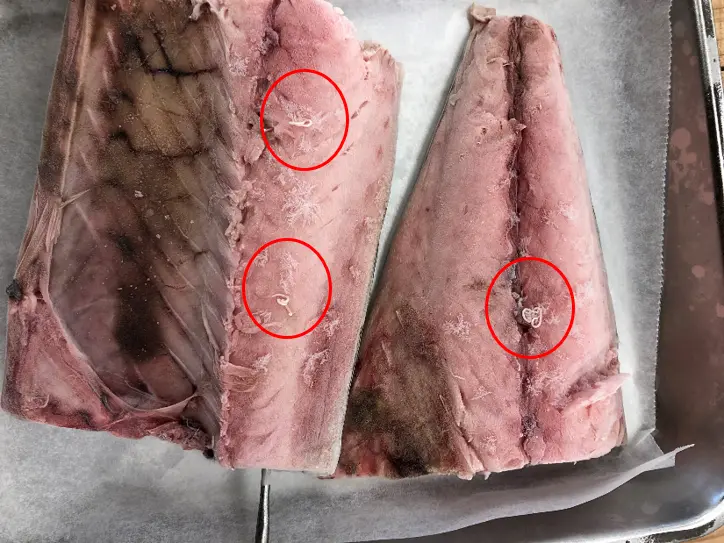
The parts circled in red are the Anisakis larva that were discovered visually. We confirmed that the parasites' bodies detected in these mackerel were Anisakis larvae, and all of them were dead. We also observed their motility under a microscope after 12 and 24 hours, and it was confirmed that they stopped moving completely. In addition to the Anisakis found visually, one of each was also detected inside the muscle. It became clear that the parasite could not be removed by visual inspection alone.
Observing temperature changes in commercial freezers and their limitations
In addition to verifying the death of Anisakiasis by rapid and flash freezing, we observed the temperature change of mackerel in rapid and flash freezing and two types of general commercial freezers (A: -24℃ setting, B: -20℃ setting), and found that -24℃ commercial freezers set at -20°C take about 10 times as long (minutes) as rapid and flash freezing to reach -20°C, and commercial freezers set at -20°C struggled to maintain -20°C for 24 hours.
Flash freezing mackerel
The time required to reach -20℃ is 25 minutes. After confirming that the temperature was below -30℃ in the flash freezer, we moved it to a commercial freezer A set at -24℃, but the temperature never exceeded -20℃.
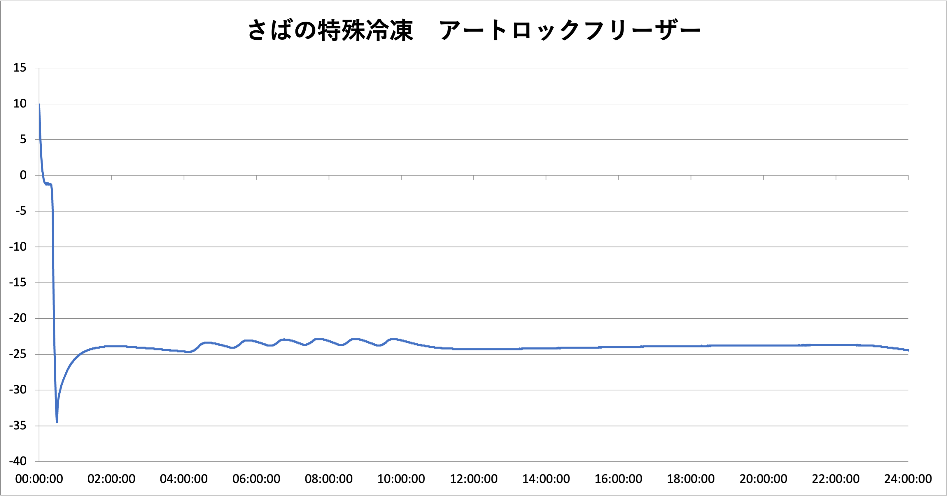
Mackerel frozen for 48 hours in commercial freezer A (-24℃ setting)
The time required to reach -20℃ is 360 minutes (approximately 10 times longer than flash freezing).
After reaching -20℃, there was a slight rise in temperature, but it never exceeded -20℃.
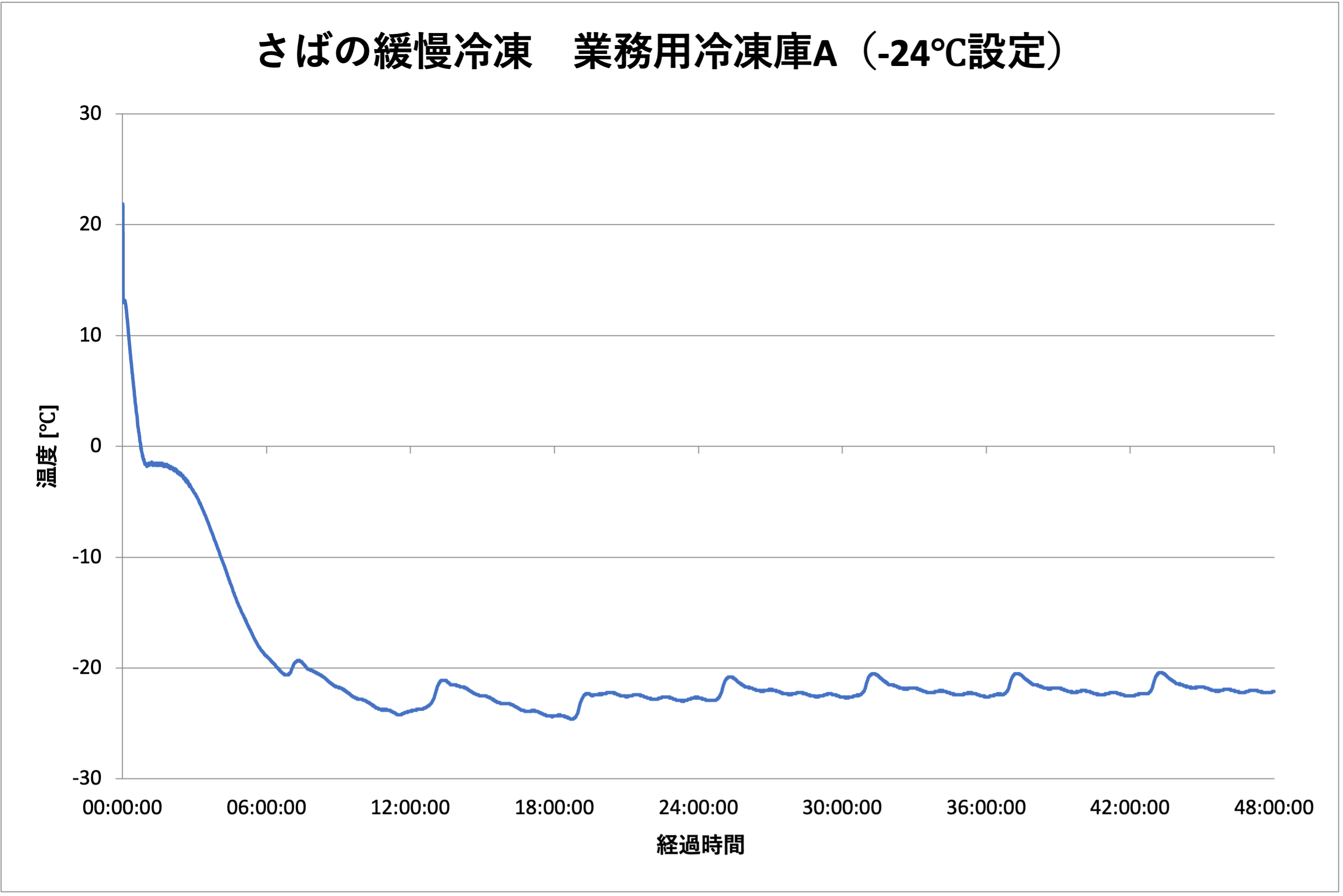
Mackerel frozen for 48 hours in commercial freezer B (-20℃ setting)
Although the minimum temperature reaches -20℃, it is difficult to maintain the temperature below -20℃ for 24 hours as stipulated by the Japanese Ministry of Health, Labor and Welfare due to the temperature rise inside the chamber when defrosting.
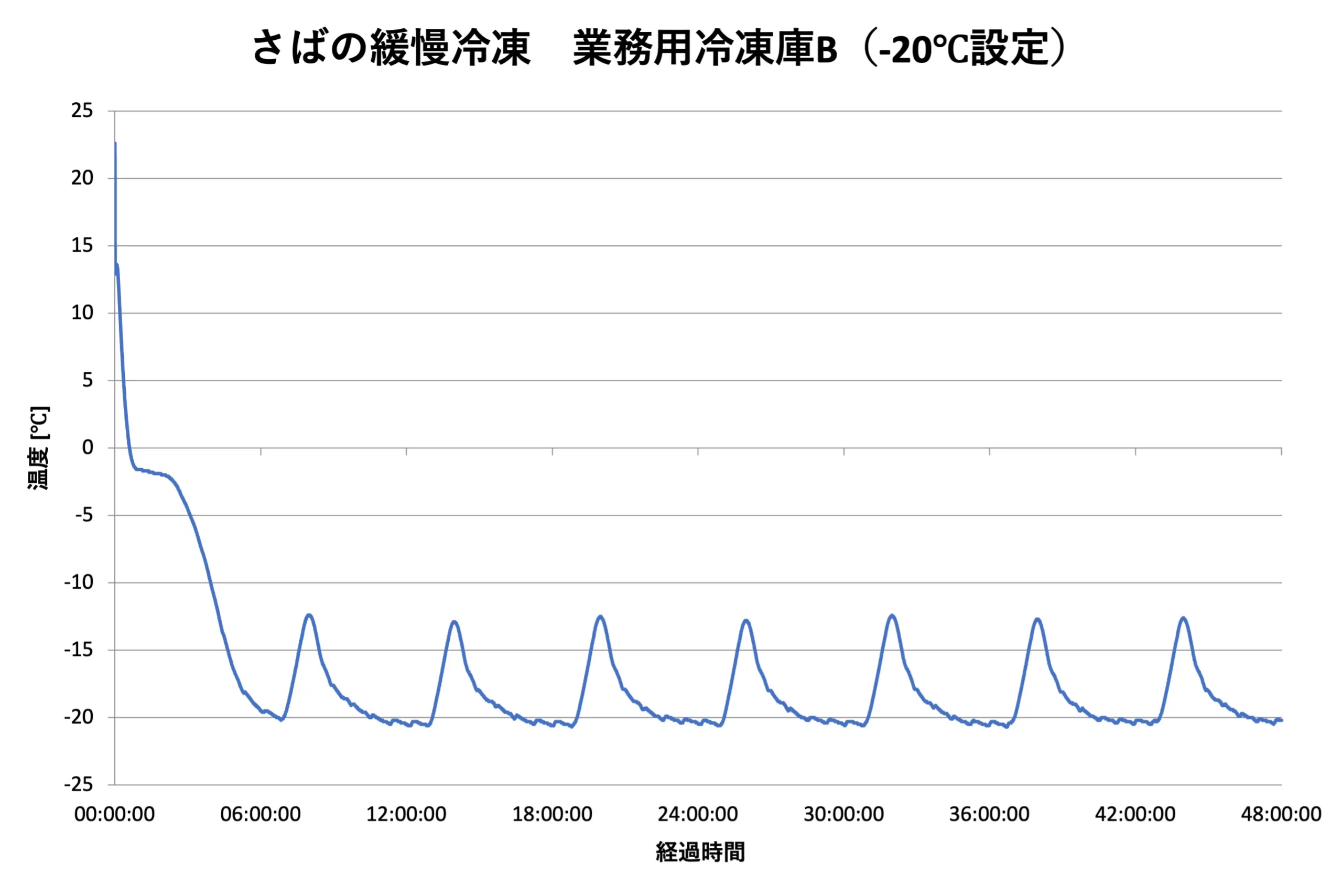
These results revealed that for general commercial use, depending on the temperature and environment of the freezer, it may not be possible to achieve temperatures below -20℃ for 24 hours. On the other hand, rapid or flash freezing takes about 1/10th the time required for commercial freezers to reach temperatures below -20℃. It has been demonstrated that a fast and stable freezing method is effective to kill anisakis.
How to prevent food poisoning while maintaining the quality with rapid and flash freezers?
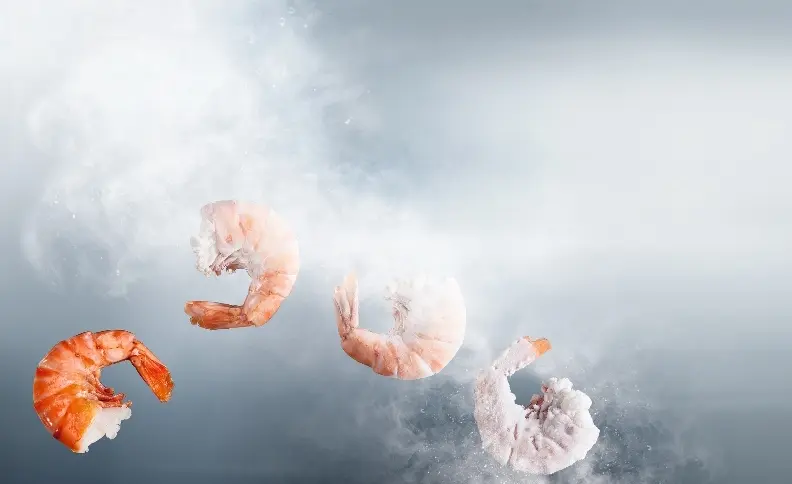
Rapid or flash freezing is a freezing method that quickly passes through the temperature range where the water content of food freezes (maximum ice crystal formation temperature range).
Normal commercial freezers have a temperature of -20°C, but rapid or flash freezer can quickly freeze food at a very low temperature of -35°C. Therefore, the time required for freezing is reduced to less than 1/3 compared to a regular freezer.
According to international organizations, at -35°C, the time needed to kill Anisakis can be reduced to 15 hours.
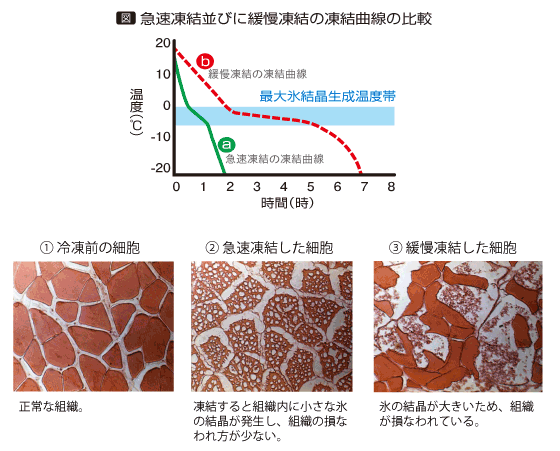
We recommend a freezer stocker for storage after freezing in your raw food in a rapid or flash freezer.
Freezer stockers are used for storage rather than freezing, so there is no frost and there is no need to worry about temperature increases due to defrosting. The combination of a rapid or flash freezer and a freezer stocker allows for stable low temperature control in a short period of time, and is a very effective way for killing Anisakis.
In addition, quality deterioration was an issue when freezing the food that had Anisakis. In the case of general commercial and home freezers, there is a risk that the Anisakis will not die due to the set temperature and the temperature rise inside the freezer, and freezing destroys the cell membrane, which spoils the taste of the fish when it is thawed and eaten, forcing you to throw it away.
On the other hand, rapid or flash freezing has a fast freezing speed, which suppresses the expansion of ice crystals and prevents cell destruction within the food. The flavor components will be preserved when thawing, and the quality will be the same as before freezing. Let's take a look at an example of a restaurant that uses rapid freezing to freeze food and prevent Anisakis food poisoning.
Examples of measures against Anisakis using rapid and flash freezing
Seafood restaurant
This is a seafood restaurant with a reputation for freshly caught fish, with sardine sashimi being their signature dish. flash freezing kills Anisakis and provides safe and delicious fish dishes.
[Anisakis flash freezing method]
Fish species: Sardines, bonito, etc.
・Step 1: flash freezing for 60 to 90 minutes
・Step 2: Store in a freezer stocker (-60℃ setting) for more than 1 day
・Step 3: Defrost and prepare the amount expected to be used that day in ice water the same morning.
・Step 4: After ordering, prepare the fish and serve it as sashimi or sushi.
[Owner's testimonial]
Raw fish infected with Anisakiasis are always flash frozen before cooking. Since relying on flash freezing, there have been zero cases of Anisakis food poisoning, and even when we serve flash frozen /thawed sashimi to our customers, they don't notice that it has been frozen at all. Although guidance from the public health center was required, I was able to clear the hygiene and food safety check without any problems when I explained my method. In addition to preventing Anisakis food poisoning, we also use fish that we have frozen in stock when fish is in short supply, allowing us to consistently provide popular menu items. By flash freezing freshly harvested food, you can enjoy a fresher taste after thawing. Flash freezing is essential for providing fish dishes that are stable in both safety and quality.
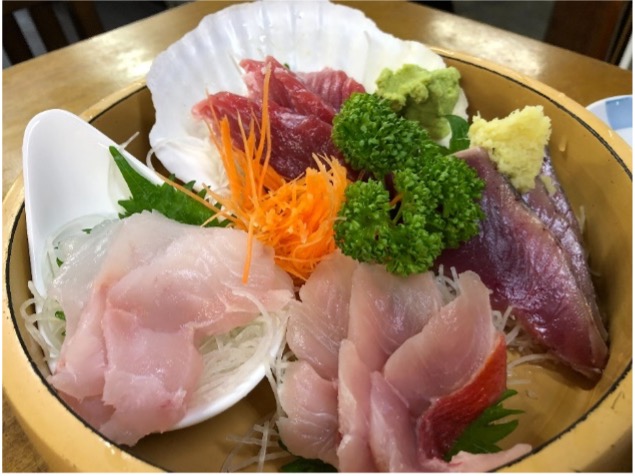
What are the risks at home?
Finally, we will explain the risks of Anisakis in raw fish, frozen tuna, and farmed fish sold in supermarkets.
Raw edible fish at the supermarket
Many of the raw fish for home consumption sold in supermarkets are frozen at the store. Foods that say "thawed" on the label are a sign that they have been frozen, so the risk of anisakiasis is very low. If the item does not say ``thawed,'' it is best to check with the store staff to see if it has been frozen.
Foods that indicate that they are meant to be cooked may not have been frozen, so be careful not to eat them raw.
Frozen tuna
In the case of pelagic tuna and other fish landed by deep-sea fishing boats, they are rapid or flash frozen on the fishing boat to prevent freshness deterioration , and then stored in a frozen warehouse at -60℃ for several days before being transported.
This minimizes the chances of frozen tuna having any parasites in them. However, even tuna may be landed in nearby waters and stored and transported in cooling water, so just because it's tuna doesn't mean it doesn't have Anisakis.
Farmed fish
Farmed fish also have a low risk of containing Anisakis. However, if raw fish is used as bait, there is a risk that the raw fish may be contaminated with Anisakis which will then contaminate the farmed fish. There have been cases of Anisakis infesting farmed fish in the past, so it is safer to freeze farmed fish if you plan to eat them raw.
Conclusion
Anisakiasis, which is a fish parasite, can cause severe pain and food poisoning called anisakiasis if eaten.
The ways to prevent food poisoning caused by Anisakis include removing the internal organs while they are still fresh, visually inspecting them, cooking them, and freezing them. Among them, freezing is the best way to enjoy sushi and sashimi.
In the case of freezing, Anisakis can be killed by freezing the fish at -20°C for 24 hours or more, but this is not sufficient enough for regular freezers due to the rise in temperature inside the freezer. Therefore, we recommend a combination of rapid or flash freezing and freezer stocker.
The combination of rapid or flash freezing and freezer stockers is very effective in killing Anisakis because it allows stable low temperature control in a short period of time. Since it does not destroy food cells, the quality before freezing can be maintained even after thawing.
If you would like to hear more details about rapid and flash freezing and the treatment of Anisakis in frozen stockers, or if you would like us to perform a freezing test for you first, please feel free to contact us.








![[Storage period increased by 30 times! ] Achieving a stable supply of raw whitebait!](https://shunkashutou.com/wp-content/uploads/2016/11/579c55e6d32e1385c250e8e7c3ed59a71.jpg)
![[Sales increased 100 times! ] rapid freezing the signature menu “Ni-katsu sandwich”!](https://shunkashutou.com/wp-content/uploads/2016/11/IMG_02391.jpg)
![[Horse sashimi] We have significantly reduced waste loss with rapid freezer!](https://shunkashutou.com/wp-content/uploads/2016/11/5fda59d0cbcdabde18e58c3c58c09ed0.jpg)




![[Storage period increased from 3 days to half a year! ] Restaurants are expanding their business using wholesale and mail order!](https://shunkashutou.com/wp-content/uploads/2018/04/66c19942ab4ba346fdb64ccc04cde373.png)
![[Reduce loss from 200 kg of oysters to zero] Improve loss and expand business with rapid freezer](https://shunkashutou.com/wp-content/uploads/2018/06/19785ca583a8d3c4041c7c192d041b0d.jpg)














![[Explanation with photos] How to freeze octopus, storage period, and 5 recipes!](https://shunkashutou.com/wp-content/uploads/2023/10/5128a2b3fa3cc254cffab87821372215.jpg)
![[Includes recommendations by industry] Summary of types and benefits of small rapid freezer](https://shunkashutou.com/wp-content/uploads/2020/12/smallsize.jpg)
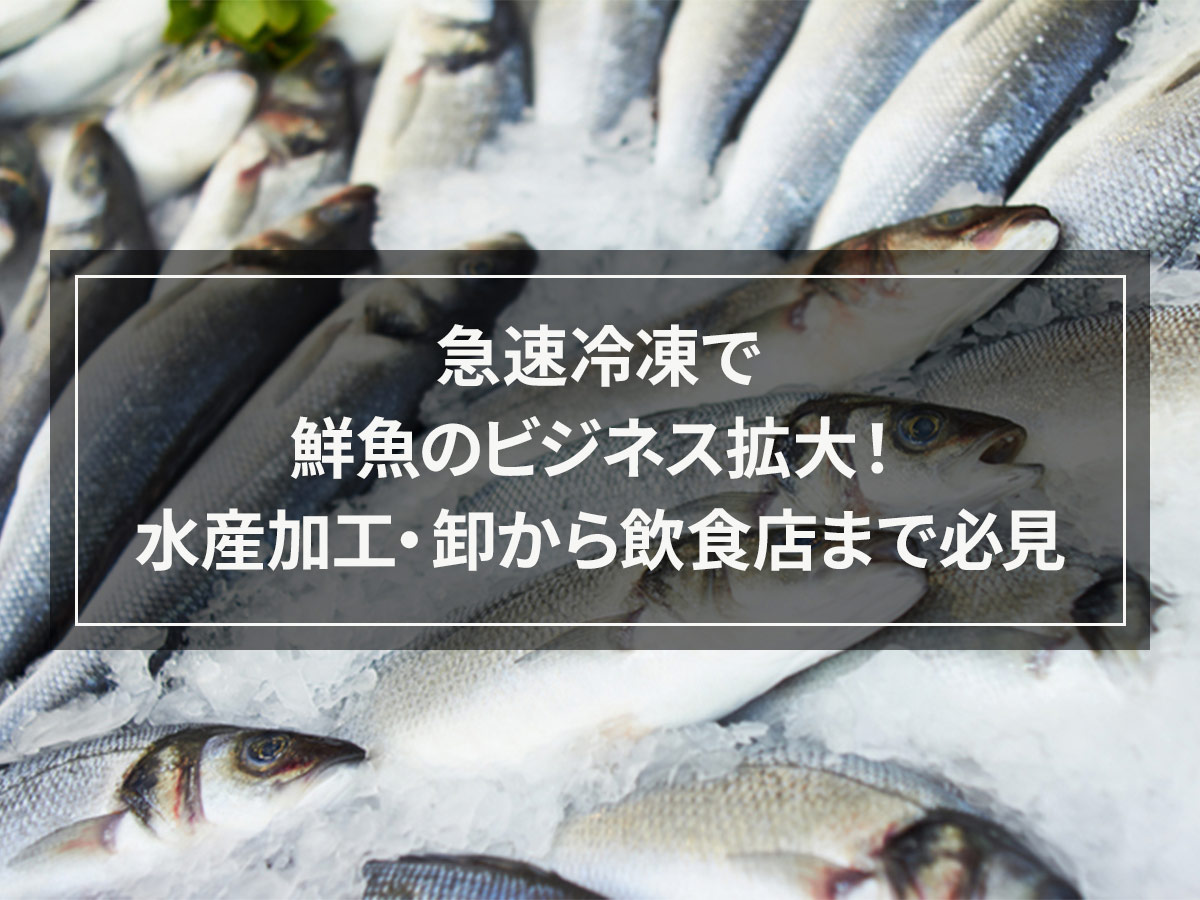
![[Explaining how to freeze fish! ] Introducing storage period and thawing method!](https://shunkashutou.com/wp-content/uploads/2023/08/a794d4ac4e5f56cd881ba06a0edf9449.jpg)
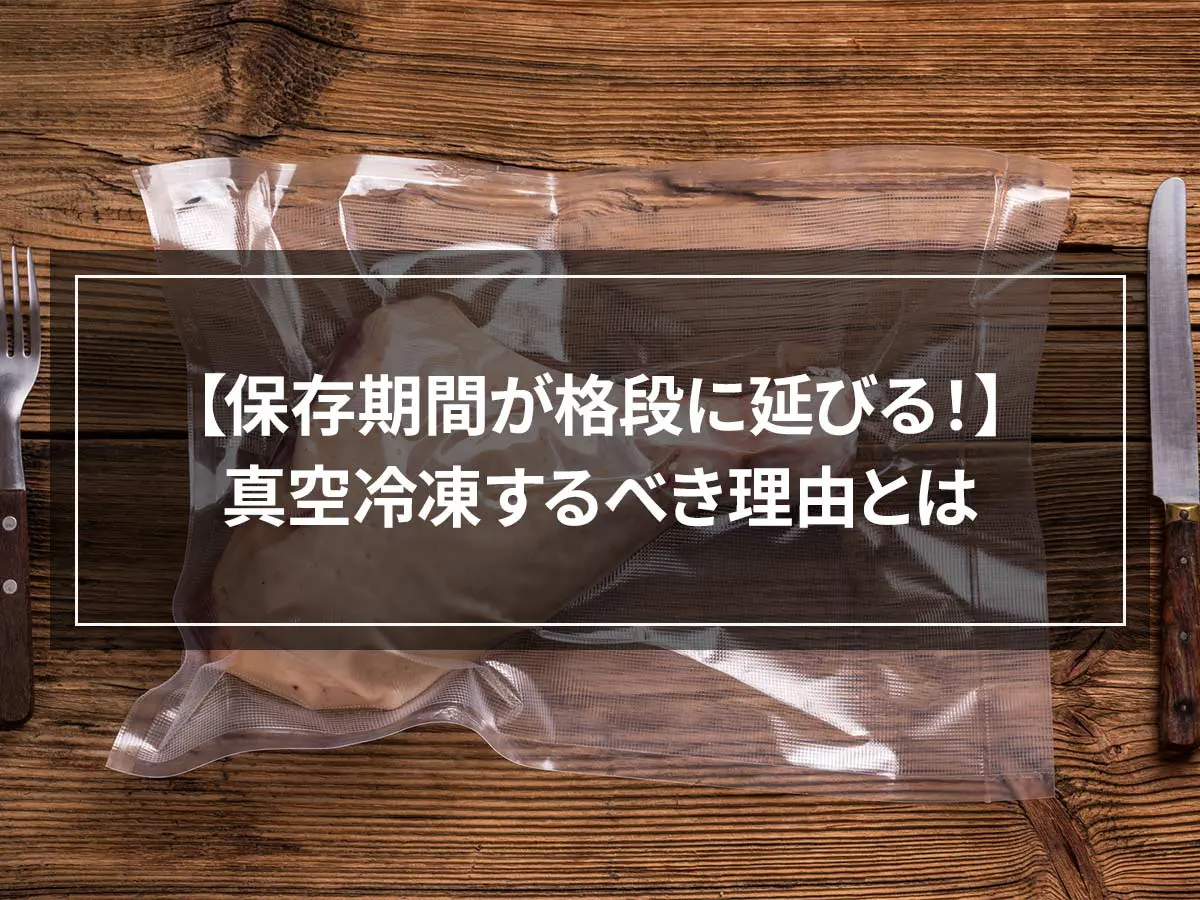
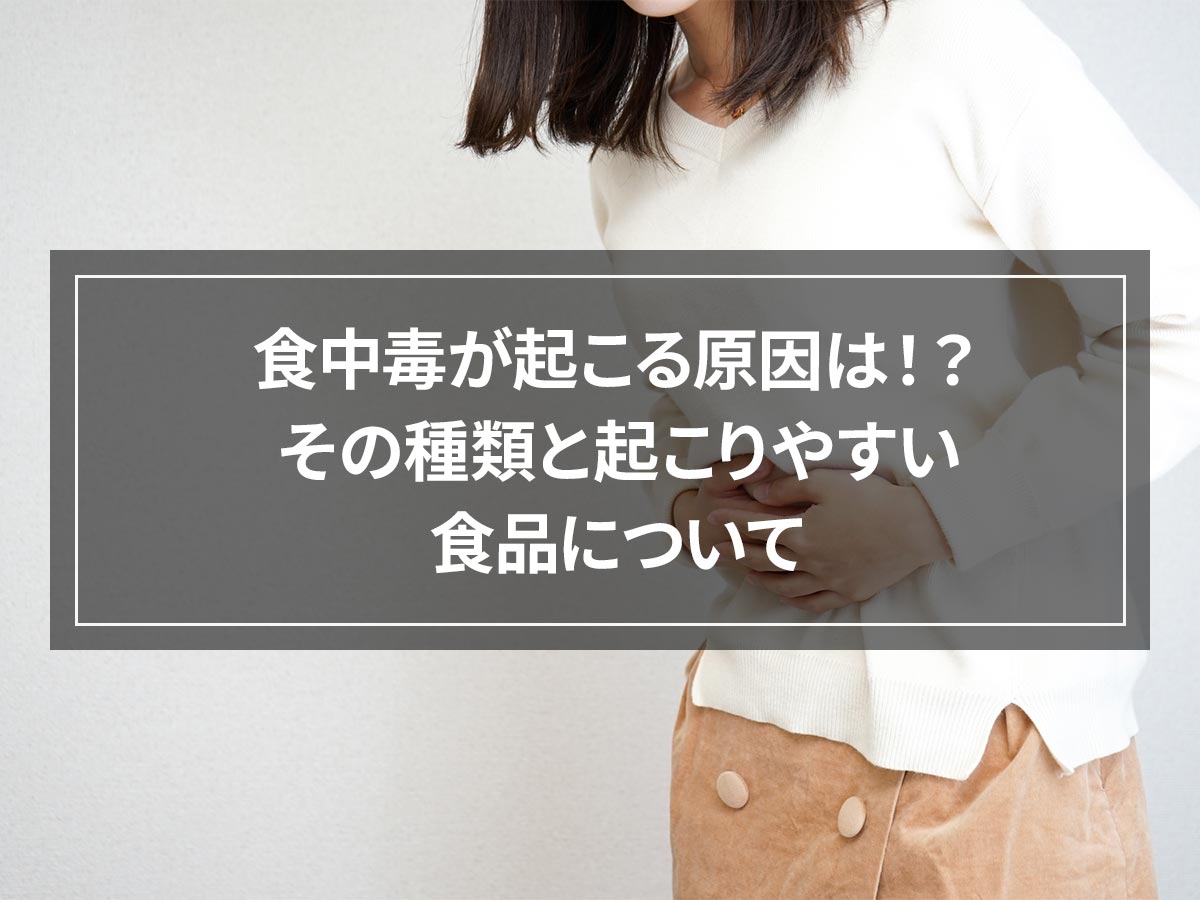
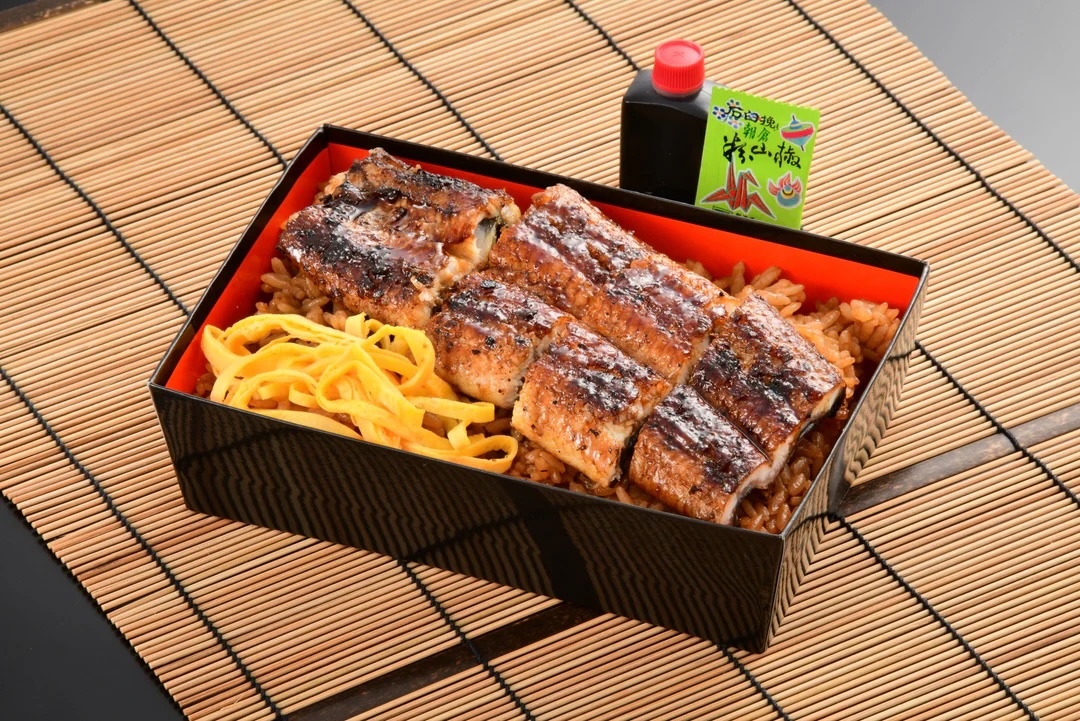
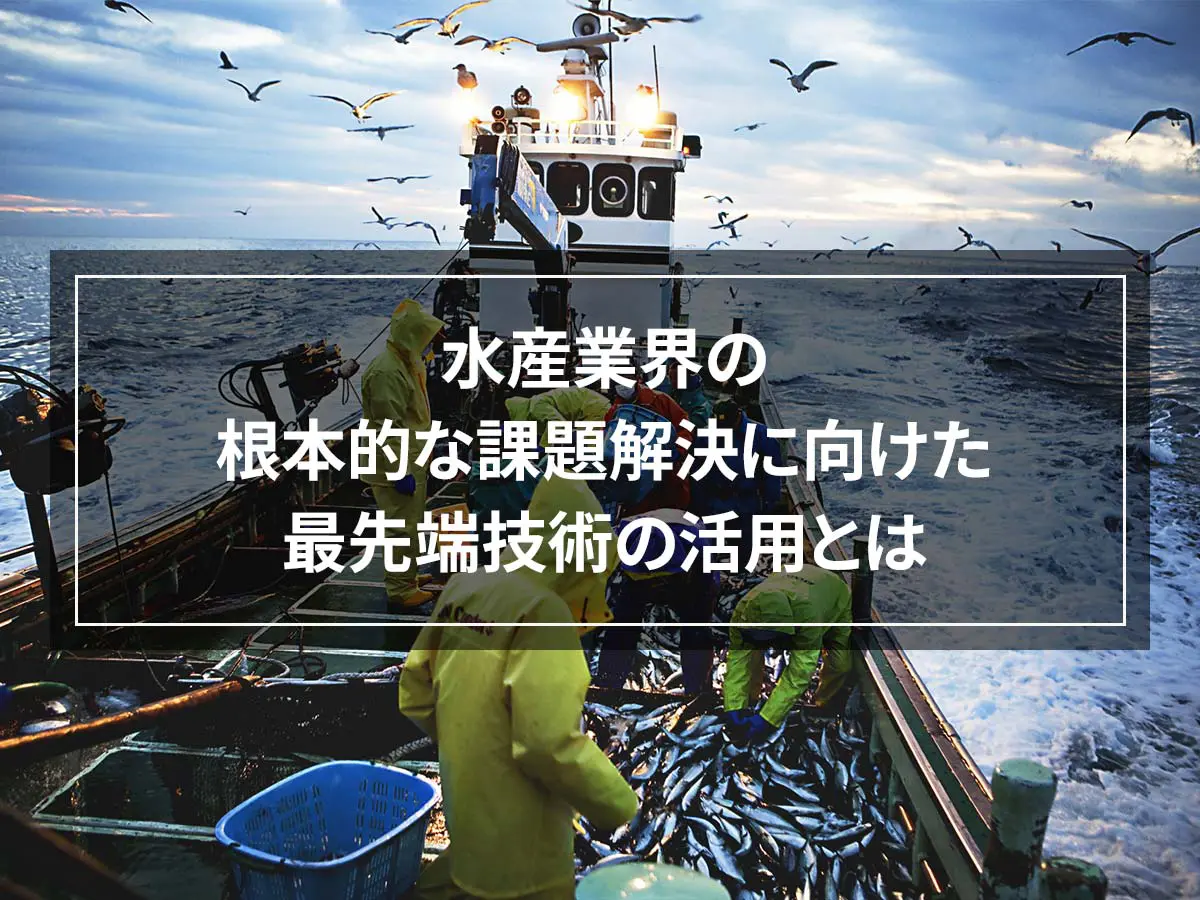
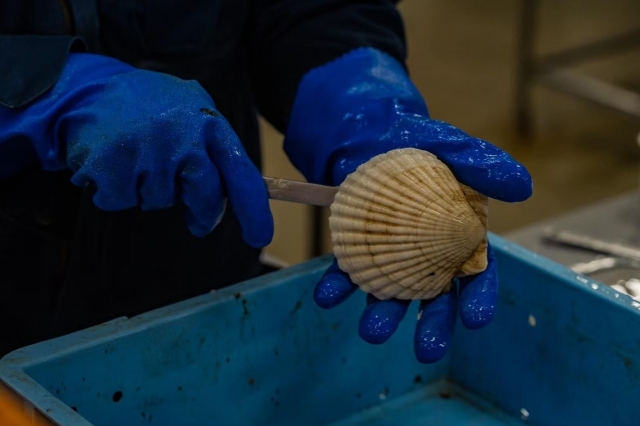
![[Great at sushi restaurants! ] How to increase sales by rapid freezing sushi](https://shunkashutou.com/wp-content/uploads/2016/04/0d3e7f8a3cefa0aefe0a8452e414db21.jpg)
![[Explanation with photos! ] How to freeze mackerel fillets and 5 carefully selected recipes!](https://shunkashutou.com/wp-content/uploads/2023/10/bf45f102162a8d43387d3a8d3e538034.jpg)

![[Safely distribute delicious fish! ] Kill Anisakis with rapid freezing technology!](https://shunkashutou.com/wp-content/uploads/2024/10/99093c5fe8b0d716c39df907616e4a96.webp)
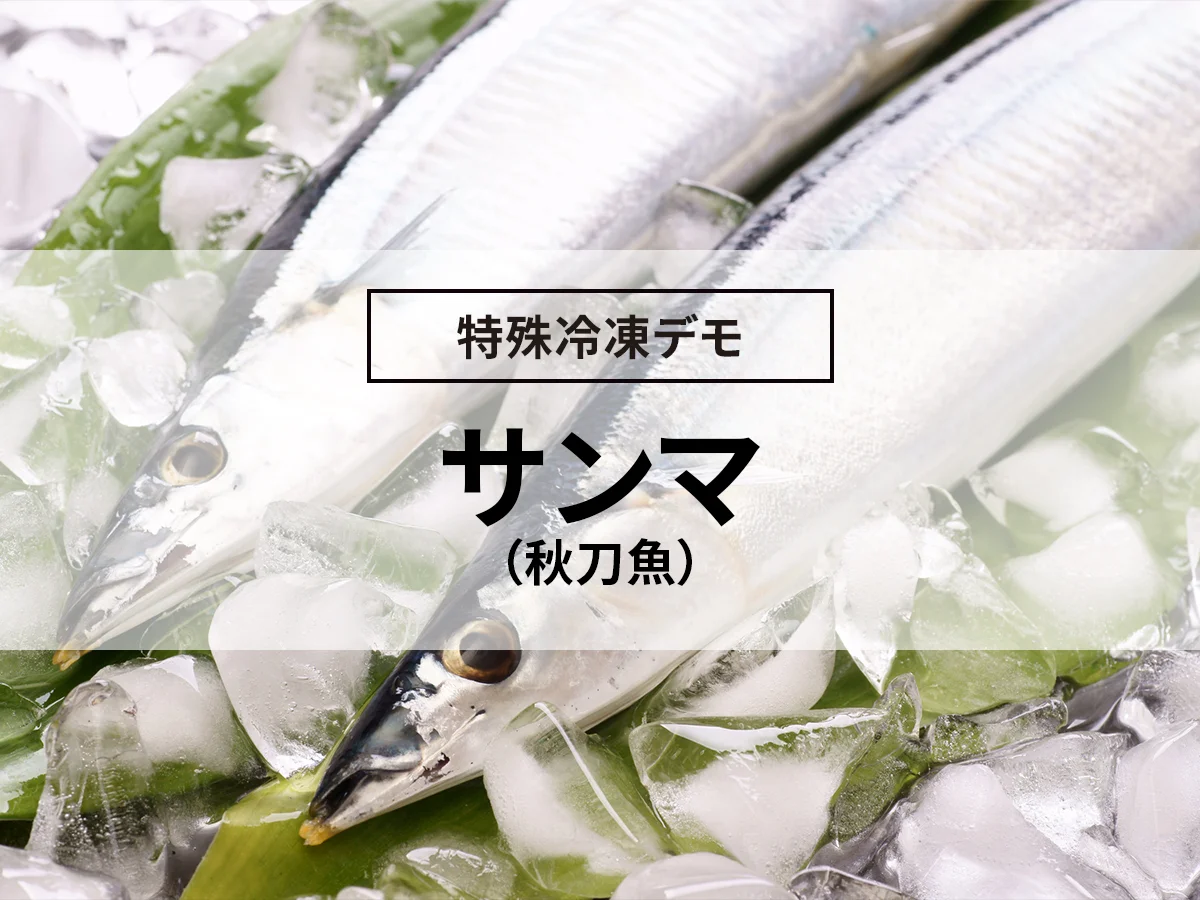
![[Guide to handling frozen chicken for commercial use] How to thaw and how long it can be used after that](https://shunkashutou.com/wp-content/uploads/2018/04/36a79f65c113cc4318afbc48fa6229b7.webp)

![[Rapid defrosting or slow defrosting] Unsure of which method? Read the complete guide on how to defrost](https://shunkashutou.com/wp-content/uploads/2024/10/ec8d0eb82bcecb5525574a8f72183a97.webp)


![[Deliver delicious ham! ] Meat processing manufacturer’s rapid freezing implementation example](https://shunkashutou.com/wp-content/uploads/2024/09/0825c4a97ac8495fd2408a91574cede6.webp)

![Introducing how to freeze/thaw salmon roe and how long to store it [includes carefully selected recipes]](https://shunkashutou.com/wp-content/uploads/2023/09/236b884b68d07d2f5983f2b9ea66583d.jpg)
![Introducing how to freeze and thaw whitebait, as well as recipes for its use [Full of nutrition! ]](https://shunkashutou.com/wp-content/uploads/2023/10/04d15012ec36f91a5574f63dfa9d4771.jpg)
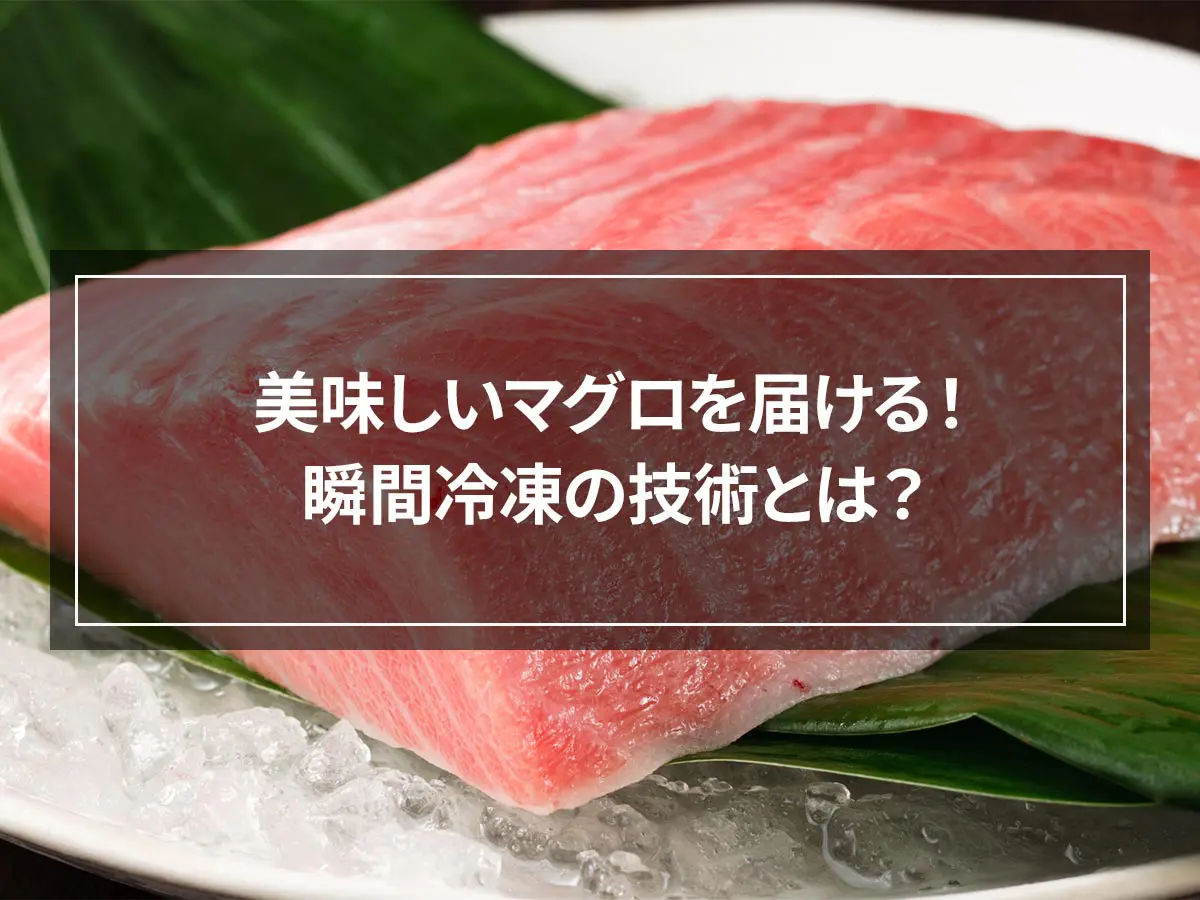
![[How to use leftover sashimi! ] Introducing frozen preservation methods and arrangement recipes](https://shunkashutou.com/wp-content/uploads/2023/10/7451dbe2231dbc559fe002350b8add67.jpg)
![[Explanation with photos! ] How to freeze saury, storage period, and 5 recipes!](https://shunkashutou.com/wp-content/uploads/2023/10/fff0f92d808aca2392b3eb576f218f08.jpg)
![[Explanation with photos] Freezing and storage period of yellowtail fillets, carefully selected recipes!](https://shunkashutou.com/wp-content/uploads/2023/08/2613b1c938d382e3afc17125432167f0-1.jpg)
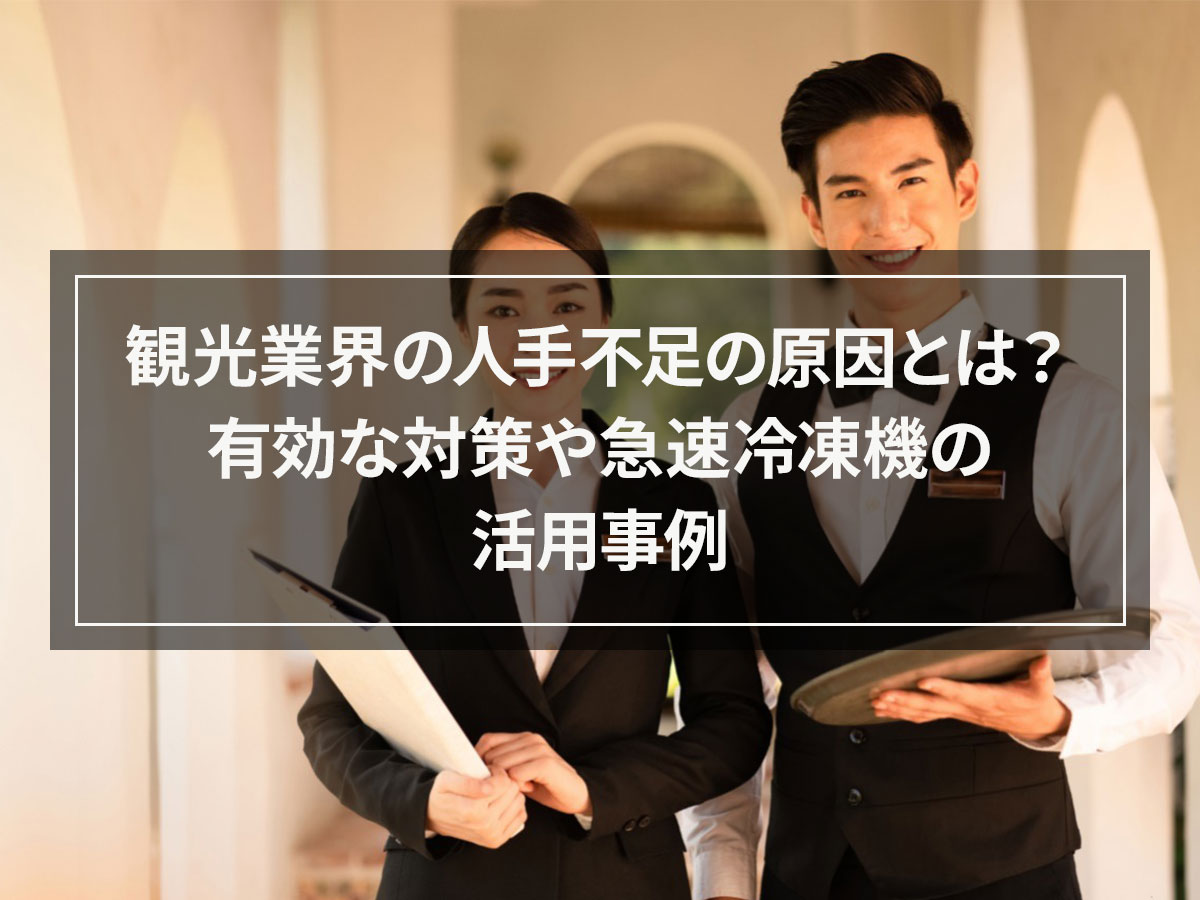
![[Improve customer satisfaction] What can be solved by introducing rapid freezer at a lunch box delivery company for the elderly?](https://shunkashutou.com/wp-content/uploads/2024/07/c8a5aa8730d5ae7441fd1aa6ee8757ef.webp)

![[Introducing case studies as well!] 5 reasons why curry restaurants should install rapid freezer](https://shunkashutou.com/wp-content/uploads/2024/07/2a0deb9a6db53165f0a4938bc80cee46.webp)
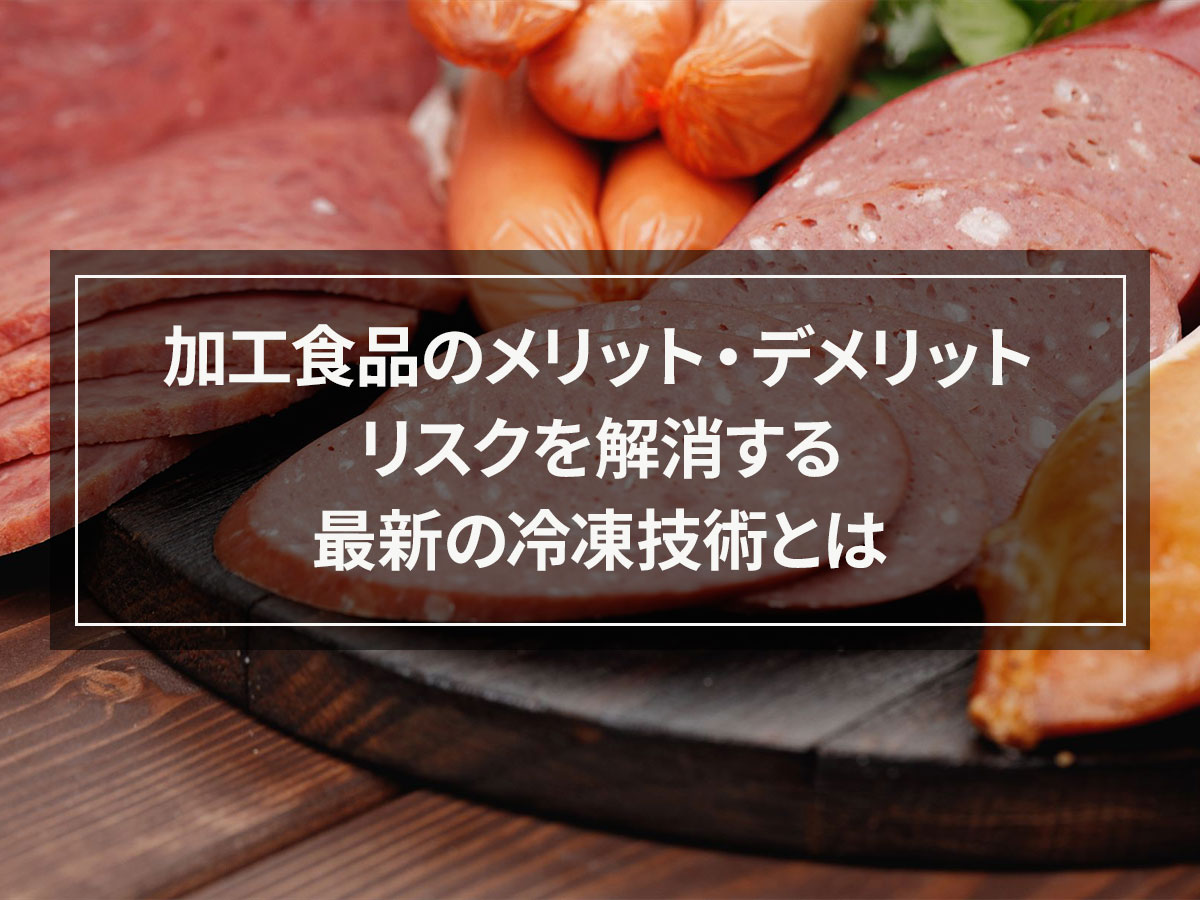

![[Achieving instant freezing at home] The evolving freezing function of home refrigerators](https://shunkashutou.com/wp-content/uploads/2015/10/93e403bcf18bda6b2d63c7c74fdef064.jpg)



